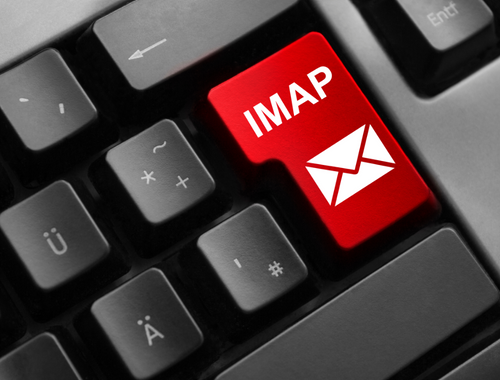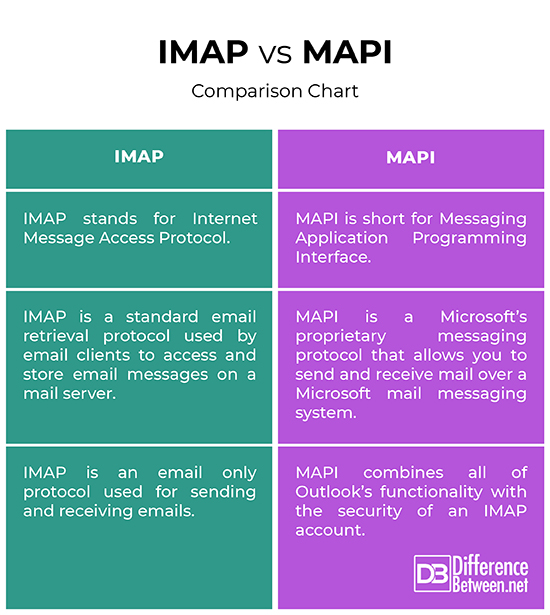Difference Between IMAP and MAPI
Just like everything else, you might want to do a little research or do some homework before obtaining your email account or configuring it. Before you sign on the dotted line you might want to ask your email provider exactly what services it offers. Many providers provide you with a number of methods, such as IMAP and MAP. These are basically protocols for communication between mail clients and mail servers. Each protocol has distinct supported features. We look at the two protocols and try to understand the differences between the two.

IMAP
IMAP, short for Internet Message Access Protocol, is a standard email retrieval protocol used by email clients to access and store email messages on a mail server. It is the open standard protocol for retrieving mail for a specific user from a server. IMAP is the protocol that facilitates sending and receiving of emails and shows it on different devices and syncing it with your server. With an IMAP account, your email is stored on the mail server of your ISP. This way, you can store and process mail, and also download it to the local computer you are working on. It allows mobile and desktop email applications to access email on a mail server. It was developed as an alternative to the Post Office Protocol, commonly goes by POP.

MAPI
MAPI, short for Messaging Application Programming Interface, is a Microsoft Windows program that allows client programs to become messaging enabled. MAPI, like IMAP, is a messaging protocol that allows users to access their mailbox through Outlook or other email clients supported by MAPI. It is a Microsoft’s proprietary communication protocol that enables an application to send and receive mail over a Microsoft Mail messaging system. MAPI is used in Outlook with a mail server that is running Microsoft Exchange Server. It is a lot like IMAP, but allows you to combine all the functionality of Outlook with the security of an IMAP account. This type of email account is commonly found in a medium or large business environment. It’s designed to separate the mail engine from the mail client.
Difference between IMAP and MAPI
Protocol
– IMAP stands for Internet Message Access Protocol and is the open standard protocol used by email clients to access and store email messages on a mail server. It is just an email protocol, a method for sending and receiving emails and syncing it across different devices. MAPI, short for Messaging Application Programming Interface, is Microsoft’s proprietary messaging protocol that allows Windows applications to send and receive emails. Unlike IMAP, MAPI is a full groupware protocol used by Microsoft Exchange and Outlook for email, contacts, etc.
Functionality
– IMAP is an email only protocol used for sending and receiving emails and synchronizing your mailbox between the cloud and the email client. This allows you to access email on a remote server from a local client. It allows mobile and desktop email applications to access email on a mail server. MAPI, on the other hand, allows you to combine all of Outlook’s functionality with the security of an IMAP account. In addition to your email messages, your contacts, calendar, tasks, appointments, and everything else is stored in your mailbox on the server.
Security
– With IMAP, your mail is only available on the server, which means you cannot access the old messages if there is no or limited internet connectivity. While IMAP transmits all the contents of your messages in plain text which makes it easy to intercept, it can use SSL encryption to encrypt messages. MAPI is more secure than IMAP because it allows you to use 128-bit RPC encryption in the Outlook user profile. MAPI also provides a live connection to the server.
IMAP vs. MAPI: Comparison Chart

Summary
In a nutshell, both IMAP and MAPI are email messaging protocols that share basically the same functionality, except MAPI is Microsoft’s proprietary messaging protocol that combines all of Outlook’s functionality with the security of an IMAP account. It is a full-fledged messaging system used by Microsoft Exchange and Outlook for email, contacts, appointments, tasks, etc. Unlike IMAP, MAPI also allows a live connection to the server. MAPI is a Remote Procedure Call (RPC) protocol that provides a very rich interface to your Exchange mailbox.
Is MAPI more secure than IMAP?
MAPI is more secure than IMAP because it allows you to use 128-bit RPC encryption in the Outlook user profile.
What is MAPI used for?
MAPI is used in Outlook with a mail server that is running Microsoft Exchange Server. It allows you to access your mailbox using Outlook or other MAPI email clients.
What is MAPI email?
MAPI is a Microsoft’s proprietary messaging protocol that allows users to access their mailbox through Outlook or other email clients supported by MAPI.
What is the difference between MAPI and SMTP?
MAPI allows you to send and receive emails through Outlook and other MAPI email clients and it has access to the folders like the inbox and the outbox. SMTP (Simple Mail Transfer Protocol), as the name suggests, is exclusively used for sending email across the internet.
Does Outlook use MAPI or IMAP?
MAPI is used in Outlook with a mail server that is running Microsoft Exchange Server.
What port does MAPI use?
MAPI requires HTTP port 80 and HTTPS port 443 in order to function.
- Difference Between Caucus and Primary - June 18, 2024
- Difference Between PPO and POS - May 30, 2024
- Difference Between RFID and NFC - May 28, 2024
Search DifferenceBetween.net :
Leave a Response
References :
[0]Fredricks, Karen S. and Jennifer Fulton. Outlook 2007 All-in-One Desk Reference For Dummies. New Jersey, United States: John Wiley & Sons, 2011. Print
[1]Gaiser, Ted J. and Anthony E. Schreiner. A Guide to Conducting Online Research. California, United States: SAGE Publications, 2009. Print
[2]Zwicky, Elizabeth D., et al. Building Internet Firewalls: Internet and Web Security. California, United States: O'Reilly Media, 2000. Print
